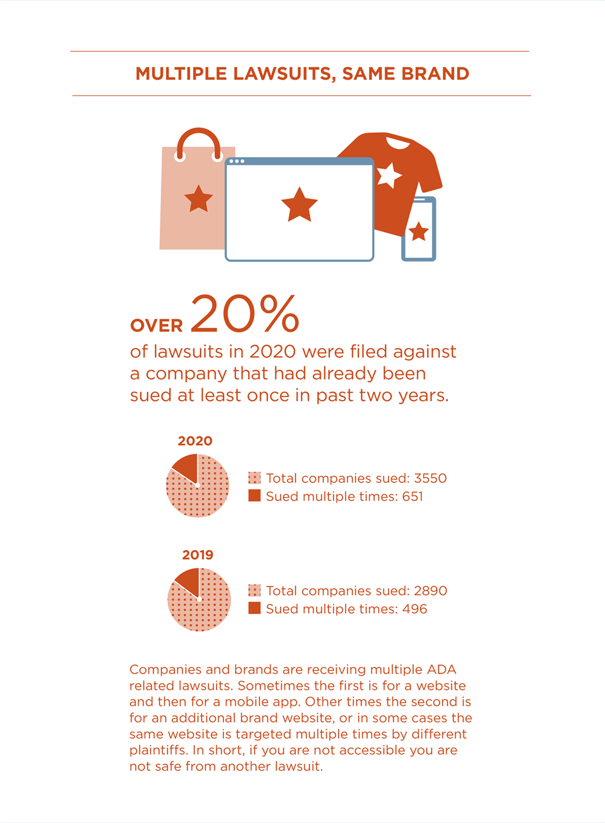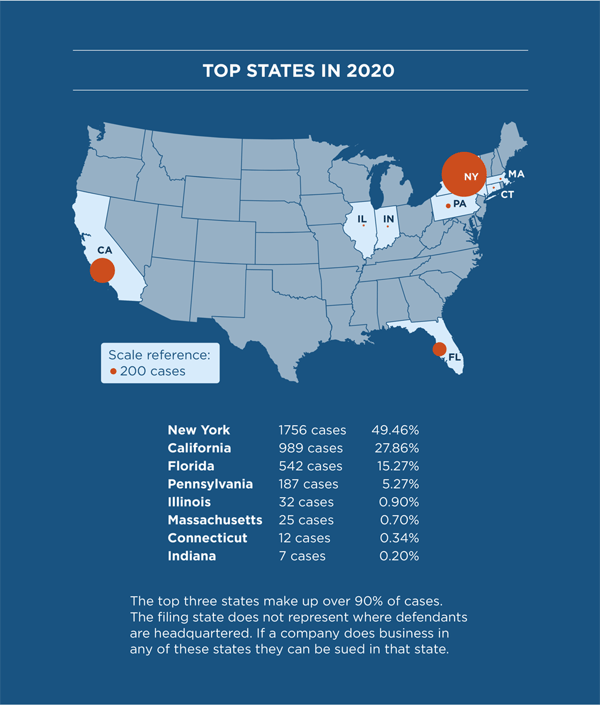In 2020, web, app and video accessibility cases are up almost 25% year-on-year. December saw an almost 100% rise over January.
Total digital accessibility lawsuits in 2020 exceeds 3,500. When you combine federal and state ADA lawsuits, the trend is moving upward.
Accessibility Cases citing the ADA Accelerate

Plaintiffs keep finding websites with lots of accessibility issues. (A 2020 WebAIM research report found that 98.1% of the top 1,000,000 websites’ home pages had detectable WCAG failures).
It is becoming easier for plaintiff firms to document issues and build their claim. It is fast and easy to visit a digital store, food delivery or financial service offering.
Companies are adding stores, websites and digital content at a rapid pace. Unfortunately, companies accessibility initiatives are not keeping up.
Plaintiff firms are getting more efficient when building and filing claims. Claims are rising at the federal and state level, especially in California with more filings under The Unruh Civil Right Act.
COVID Lockdown provided Short Pause

The lockdown in New York during April and May made a dent in the monthly filing numbers. But, after June, the lawsuits have come roaring back.
December will see a 100% rise over January.
Good Web Accessibility lacking in Retail 
Retail was the main industry for digital accessibility lawsuits in 2020, with over 70% of cases.
In 2020, thousands or retailers have websites and apps. Those websites are complicated. For retailers, Web and app content changes happen often. At the same time, web teams have limited resources.
Fix web accessibility fast or get sued again

Another trend that continued, companies get more lawsuits if issues are ignored. There is a one in five chance that a company will receive a second lawsuit within 12 months of the first.
Lawsuits can be for the same website or for another digital experience, such as an app.
New York and California have the most Web accessibility lawsuits

New York and California are the top states for digital accessibility lawsuits. Both states allow plaintiffs to sue in federal or state court. These state courts favor plaintiffs.
Remember, plaintiffs can sue a company in any state where that company conducts business.
ADA lawsuits cover more than web accessibility

The type of digital experiences listed in ADA claims are starting to get broader. Video accessibility appeared in accessibility lawsuits more often in 2020. It's easy to argue that missing closed captions or audio descriptions violate the ADA.
The Unruh Act provides $4,000 for each violation, so using video is a simple and direct way to make a case.
Widgets and overlays fail to protect companies

More than 200 cases were against companies that used accessibility widgets or overlays. These solutions do nothing to make a website more accessible for the blind.
Because issues are not resolved and code is not fixed, plaintiff "testers" find violations. Widget and overlay vendors didn't protect companies from ADA lawsuits.
A Small Group of plaintiff Law Firms file most ADA Web Accessibility Lawsuits

The top ten plaintiff firms represent 70% of lawsuits, that’s over 2,500 cases across only ten law firms. Plaintiff firms specialize in ADA cases and represent only a few plaintiffs.
The defense side is more dispersed across over 1,000 different lawyers. The top ten law firms for defense represent about 20% of lawsuits.
More Digital Accessibility Lawsuits add to a tough year
The number of lawsuit, industries effected and digital experiences targeted rose in 2020. Fear or lawsuits adds extra costs and concerns for businesses already facing a tough year due to lockdowns.
Download our full 2020 Digital Accessibility report.
Note on Methodology
The UsableNet team monitors all ADA lawsuits filed at the federal and state level. This includes cases filed in California under the Unruh Civil Rights Act. (Unruh Act).
The research team reviews if lawsuit claims are for digital accessibility or physical. (The ADA still generates over 10,000 cases filed for physical violations each year).
The UsableNet team separates out any lawsuits related to digital accessibility. This means violations of the ADA based on content like websites, mobile apps or video.
The team logs any ADA lawsuits based on the digital accessibility. At year-end, we report on the top trends from the past several months. Our web accessibility report also looks at how the most recent year compares to past trends.



















